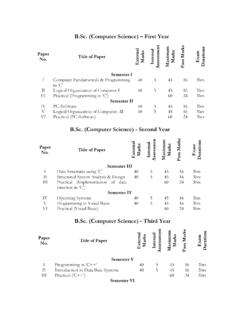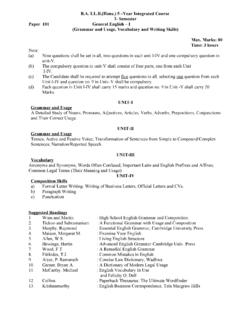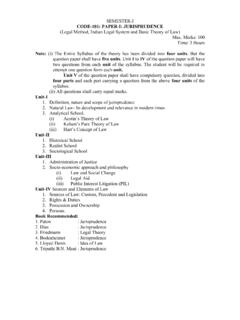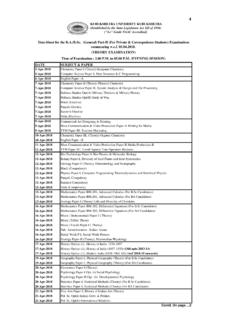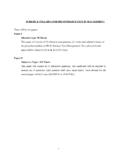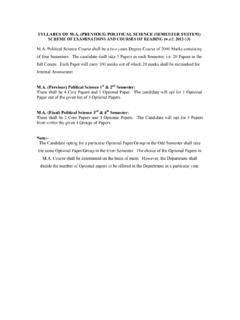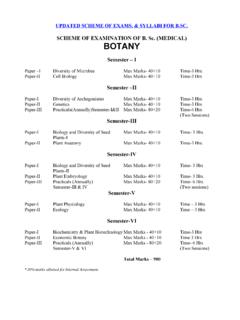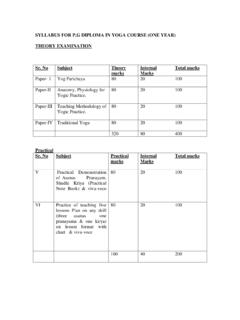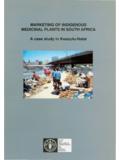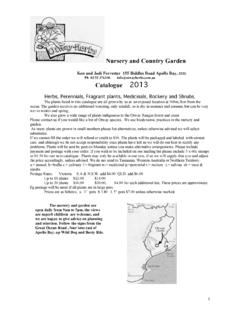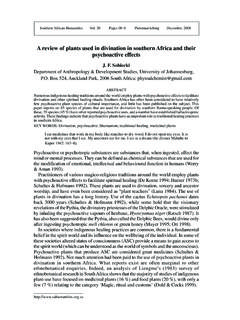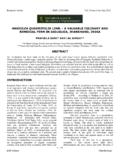Transcription of B.Sc. ENVIRONMENTAL SCIENCE - Kurukshetra …
1 ENVIRONMENTAL SCIENCE . Scheme of Examinations Ist Semester Paper-I Elements of Ecology Paper-II Ecosystem Dynamics Paper-V Practicals IInd Semester Paper-III Biodiversity Components Paper-IV Biodiversity Conservation and Ecosystem Services Paper-V Practicals Outline of Examinations Paper Nomenclature Internal External M. Marks Assessment Ist Semester I Elements of Ecology 10 40 50. II Ecosystem Dynamics 10 40 50. IInd Semester III Biodiversity 10 40 50. Components IV Biodiversity 10 40 50. Conservation and Ecosystem Services V Practicals* 0 100 100. * At the end of Second Semester Syllabus and Courses of Reading ENVIRONMENTAL SCIENCE (First Semester). ( 2008-2009). Paper-I: Elements of Ecology Max. Marks : 40 + 10(IA). Time : 3 Hours Note:- Total Nine questions will be set. The candidates will attempt 5 questions in all, one from each unit. Question number one will be compulsory, consisting of short answer question, covering the entire syllabus.
2 All the questions carry equal marks. Unit-I. Definition, Scope and basic principles of ecology and environment. Biological levels of organization, population, community, ecosystem and biosphere. Climatic factors - Solar radiations, temperature, water and precipitation. Unit-II. Soil formation, soil types, soil profiles. Physical and chemical characters of soil, Soil biological characters. Topographic factors. Unit-III. Population: Basic concepts, population characteristics density, natality, mortality, age-structure, population growth. Ecological niche and habitat. Positive and negative interactions of populations competition, predation, parasitism, mutualism. Unit-IV. Community: Basic concepts, community structure, growth forms, life form. Analytical and synthetic characters of plant community. Methods of plant community analysis. Concept of keystone species and ecotone. Paper-II: Ecosystem Dynamics Max.
3 Marks : 40 + 10(IA). Time : 3 Hours Note:- Total Nine questions will be set. The candidates will attempt 5 questions in all, one from each unit. Question number one will be compulsory, consisting of short answer question, covering the entire syllabus. All the questions carry equal marks. Unit-I. Ecosystem : Basic concepts, components of ecosystem. Trophic levels, food chains and food webs. Ecological pyramids, ecosystem functions. Energy flow in ecological systems, energy efficiencies. Unit-II. Biogeochemical Cycles : Importance, gaseous and sedimentary cycles. Carbon, Nitrogen, Phosphorus and Sulphur Cycles. Global Oxygen Cycles. Hydrological cycles. Unit-III. Succession : Concepts of succession, Types of Succession. Trends in succession. Climax and stability. Co-evolution and group selection. Unit-IV. Major biomes of the world. Characteristics of terrestrial fresh water and marine ecosystems.
4 Forests, grasslands, lake, river and marine ecosystems of India. Suggesting Reading: ELEMENTS OF ECOLOGY & ECOSYSTEM DYANAMICS. 1. Muller-Dombols, D. and Ellenberg, H. (1974). Aims and Methods of Vegetation Ecology, Wiley, New York. 2. Odum, (1983), Basic Ecology, Sanders, Philadelphia. 3. Robert Ricklefs (2001). The Ecology of Nature. Fifth Edition. Freeman and Company. 4. Singh and Singh (1992). Tropical Ecosystems: Ecology and Management. Wiley Eastern Limited, Lucknow, India. 5. Singh, (ed.) 1993. Restoration of Degraded Land: Concepts and Strategies. Rastogi Publications, Meerut. 6. Smith, (1996). Ecology and Field Biology, Harper Collins, New York. 7. Botkin, and Keller, 2000. Environment SCIENCE : Earth as a living planet. Third Edition. John Wiley and Sons Inc. Syllabus and Courses of Reading ENVIRONMENTAL SCIENCE (First Semester). ( 2008-2009). Paper-III: Biodiversity Components Max.
5 Marks : 40 + 10(IA). Time : 3 Hours Note:- Total Nine questions will be set. The candidates will attempt 5 questions in all, one from each unit. Question number one will be compulsory, consisting of short answer question, covering the entire syllabus. All the questions carry equal marks. Unit-I. Biodiversity: Basic concepts, importance and conservation needs. Species diversity, Biological and phylogenetic species concept. Basic concepts of speciation, species extinction. Unit-II. Biological classification, taxonomic nomenclature. Principles of classification and nomenclature of plants. Micro-organism: main taxonomic groups of micro-organism. Organization and function of a bacterial and fungal cell. Unit-III. General characteristics, habitat and economic importance of photosynthetic bacteria. Chemoautotrophs, bacteria, blue-green algae, yeasts, fungi and algae. Microbial toxins in environment, microbial diseases of man.
6 Unit-IV. Bryophytes and lichen, land habit in Bryophytes, role of bryophytes in soil building. Lichens as ecological indicators. Pteridophytes, gymnosperms and angiosperms, general characteristics, habitat, role in environment and economic uses. Paper-IV : Biodiversity Conservation and Ecosystem Services Max. Marks : 40 + 10 (IA). Time : 3 Hours Note:- Total Nine questions will be set. The candidates will attempt 5 questions in all, one from each unit. Question number one will be compulsory, consisting of short answer question, covering the entire syllabus. All the questions carry equal marks. Unit-I. Introduction to classification of animal kingdom. Diversity of insects, nematodes, fishes, birds, reptile and other mammals. Animal food and fisheries. Role of animal and insects in pollination and seed dispersal. Economic importance of wild life. Unit-II. Factors for decline of biological diversity.
7 Approaches for conservation of biological diversity. Protection of wild flora, fauna and natural habitats. Concept of threatened species. Threatened and endangered animals of India. Unit-III. Food, timber and medicinal plants non-timber forest produce. Importance of tropical rain forests and wetlands. Wild life sanctuaries, National Parks and Biosphere Reserve. Concept of genetic diversity, gene and germ-plasm banks. Unit-IV. Biodiversity convention. International and national efforts to conserve biodiversity. Socio-cultural aspects of biodiversity. Biotechnological needs for biodiversity conservation. Traditional knowledge and biodiversity conservation. Suggesting Reading: BIODIVERSITY COMPONENTS & BIODIVERSITY CONSERVATION AND ECOSYSTEM SERVICES. 1. Chandel, , Shukla, G. And Sharma, N. (1996). Biodiversity in Medicinal and Aromatic Plants in India Conservation and Utilization, National Bureau of Plant Genetic Resources, New Delhi.
8 2. Council of Scientific and Industrial Research (1986). The Useful Plants of India Publication and Information Directorate, CSIR, New Delhi. 3. Nair, et. al. (Eds.) (1998). Sustainable Management of Non-wood Forest Products. Faculty of Forestry, University Putra. Malaysia. 434 004 PM. Serdong, Selangor, Malaysia. 4. Soule, (ed.) (1986). Conservation Biology. The SCIENCE of Scarcity and Diversity. Sinaur Associates, Inc., Sunderland, Massachusetts. 5. Singh, , Singh, and Gupta, 2006. Ecology, Environment and Resource Conservation, Anamaya Publishers, New Delhi. Paper-V : Practical Max. Marks : 100. Time : 6 Hours (in two sessions). Section-A. 1. Determination of requisite size of the quadrant for vegetation analysis. 2. Analysis of frequency distribution of plants in a piece of vegetation by quardrat method. 3. To determine chlorophyll content of the given plant material. 4. To determine basal cover of trees in a forest ecosystem/forest plantation.
9 5. Quantitative analysis of soil organic carbon. 6. Quantitative analysis of soil pH. 7. To study pore space, water holding capacity and bulk density of soil. 8. Identification of rocks and minerals on the basis of physical characters. Section-B. 1. Temporary wet amount technique for the observation of living organism. 2. Ecological comments on charts/material/fresh plant material (as per syllabus). 3. Comments on economic uses of plant material (as per syllabus). 4. Preparation of field report based on the survey of local flora. 5. Study of centre of diversity of plants from maps. Section-C. 1. Comments on life cycle of some economically important insects. 2. Identification of museum specimens of some economically important fishes. 3. Study of flora and fauna through charts and maps. 4. Preparation of field report based on the visit to a Wild Life Sanctuary/National Park/Zoo/Biosphere Reserve.
10 Distribution of Marks: 1. One experiment from Section-A 20 marks 2. One experiment from Section-B 20 marks 3. One experiment from Section-C 20 marks 4. Viva-voce (based on theoretical aspects of Experiments prescribed) 10 marks 5. Lab Record 10 marks 6. Field Report 20 marks _____. Total 100 marks ENVIRONMENTAL SCIENCE . Scheme of Examinations IIIrd Semester Paper-VI Renewable and Non Renewable 3 periods/per week Energy Resources Paper-VII Natural Resources and 3 periods/per week Forest Management Paper-X Practicals 6 periods/per week IVth Semester Paper-VIII Physico Chemical Environment 3 periods/per week Paper-IX ENVIRONMENTAL Pollution 3 periods/per week Paper-X Practicals 6 periods/per week Outline of Examinations Paper Nomenclature Internal External M. Marks Time Assessment IIIrd Semester VI Renewable and Non 10 40 50 3-Hours Renewable Energy Resources VII Natural Resources and 10 40 50 3-Hours Forest Management IVth Semester VIII Physico Chemical 10 40 50 3-Hours Environment IX ENVIRONMENTAL 10 40 50 3-Hours Pollution X Practicals* 0 100 100 6-Hours of 2.
